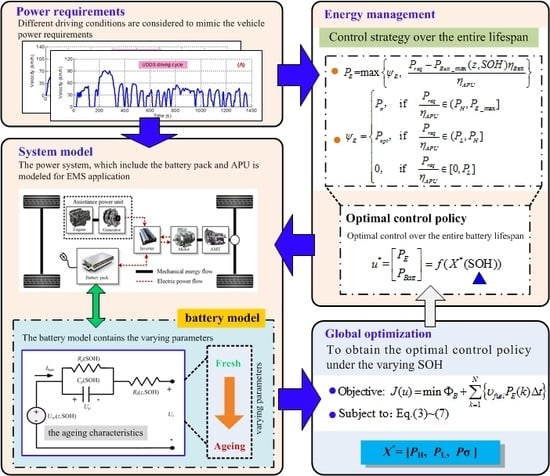Optimal Energy Management of Plug-In Hybrid Electric Vehicles Concerning the Entire Lifespan of Lithium-Ion Batteries
Abstract
1. Introduction
2. Energy Management Strategy
2.1. Problem Formulation
2.2. Control Strategy
2.3. Optimization Algorithm
3. Impacts of Battery Aging
3.1. Modeling
3.2. Exprimental Study
3.3. Mathematical Expression
- Step 1: Test data are divided into many small data segments ranging from SOC = 0.1 to SOC = 1.0; GA is implemented to optimize the model parameters at each data segment. The programming of GA has been introduced in Reference [28], so it is not reproduced here for brevity. Optimization objective is to find the best parameters ρ(j)= [Uoc(j), R0(j), Rp(j), τ(j)] to minimize the model error at each segment j. The results are shown in Figure 4.
- Step 2: Mathematical expression. From the results, we found Uoc and R0 have clear correspondences with SOC under each SOH condition, but Rp and τ show fluctuate with some certain value. Thus, Uoc and R0 at the entire SOC range are further fitted by the following continuous polynomials while Rp and τ are replaced by their mean value
4. Results and Analysis
4.1. The Impacts of Battery Aging
4.2. Energy Consumption
5. Conclusions
Author Contributions
Funding
Conflicts of Interest
References
- Khayyam, H. A Bab-Hadiashar. Adaptive intelligent energy management system of plug-in hybrid electric vehicle. Energy 2014, 69, 319–335. [Google Scholar] [CrossRef]
- Karplus, V.; Paltsev, S.; Reilly, J. Prospects for plug-in hybrid electric vehicles in the United States and Japan: A general equilibrium analysis. Transp. Res. Part A Policy Pract. 2010, 44, 620–641. [Google Scholar] [CrossRef]
- Weiller, C. Plug-in hybrid electric vehicle impacts on hourly electricity demand in the United States. Energy Policy 2011, 39, 3766–3778. [Google Scholar] [CrossRef]
- Peterson, S.; Apt, J.; Whitacre, J. Lithium-ion battery aging resulting from realistic vehicle and vehicle-to-grid utilization. J Power Sources. J. Power Sources 2010, 195, 2385–2392. [Google Scholar] [CrossRef]
- Dubarry, M.; Liaw, B.; Chen, M. Identifying battery aging mechanisms in large format Li ion cells. J Power Sources 2011, 196, 3420–3425. [Google Scholar] [CrossRef]
- Vetter, J.; Novák, P.; Wagner, M.; Veit, C.; Moller, K.; Besenhard, J.; Winter, M.; Wohlfahrt-Mehrens, M.; Vogler, C.; Hammouche, A. Ageing mechanisms in lithium-ion batteries. J Power Sources 2005, 147, 269–281. [Google Scholar] [CrossRef]
- Nuhic, A.; Terzimehic, T.; Guth, T.; Buchholz, M.; Dietmayer, K. Health diagnosis and remaining useful life prognostics of lithium-ion batteries using data-driven methods. J. Power Sources 2013, 239, 680–688. [Google Scholar] [CrossRef]
- Kim, I. A Technique for Estimating the State of Health of Lithium Batteries Through a Dual-Sliding-Mode Observer. IEEE Trans. Power Electron. 2010, 25, 1013–1022. [Google Scholar]
- Zhang, Y.; Xiong, R.; He, H.; Michael, P. Long short-term memory recurrent neural network for remaining useful life prediction of lithium-ion batteries. IEEE Trans. Veh. Technol. 2018, 67, 5695–5705. [Google Scholar] [CrossRef]
- Shams-Zahraei, M.; Kouzani, A.; Kutter, S.; Bäker, B. Integrated thermal and energy management of plug-in hybrid electric vehicles. J. Power Sources 2012, 216, 237–248. [Google Scholar] [CrossRef]
- Hou, C.; Ouyang, M.; Xu, L.; Wang, H. Approximate Pontryagin’s minimum principle applied to the energy management of plug-in hybrid electric vehicles. Appl. Energy 2015, 115, 174–189. [Google Scholar] [CrossRef]
- Li, L.; You, S.; Yang, C.; Yan, B.; Song, J.; Chen, Z. Driving-behavior-aware stochastic model predictive control for plug-in hybrid electric buses. Appl. Energy 2016, 162, 868–879. [Google Scholar] [CrossRef]
- Wirasingha, S.; Emadi, A. Classification and review of control strategies for plug-in hybrid electric vehicles. IEEE Trans. Veh. Technol. 2011, 60, 111–122. [Google Scholar] [CrossRef]
- Peng, J.; He, H.; Xiong, R. Rule based energy management strategy for a series–parallel plug-in hybrid electric bus optimized by dynamic programming. Appl. Energy 2017, 185, 1633–1643. [Google Scholar] [CrossRef]
- Gao, Y.; Ehsani, M. Design and control methodology of plug-in hybrid electric vehicles. IEEE Trans. Ind. Electron. 2010, 57, 633–640. [Google Scholar]
- Schouten, N.; Salman, M.; Kheir, N. Energy management strategies for parallel hybrid vehicles using fuzzy logic. Control Eng. Pract. 2003, 11, 171–177. [Google Scholar] [CrossRef]
- Li, S.; Sharkh, S.; Walsh, F.; Zhang, C. Energy and battery management of a plug-in series hybrid electric vehicle using fuzzy logic. IEEE Trans. Veh. Technol. 2011, 60, 3571–3585. [Google Scholar] [CrossRef]
- Zhang, S.; Xiong, R. Adaptive energy management of a plug-in hybrid electric vehicle based on driving pattern recognition and dynamic programming. Appl. Energy 2015, 155, 68–78. [Google Scholar] [CrossRef]
- Patil, R.; Filipi, Z.; Fathy, H. Comparison of supervisory control strategies for series plug-in hybrid electric vehicle powertrains through dynamic programming. IEEE Trans. Control Syst. Technol. 2014, 22, 502–509. [Google Scholar] [CrossRef]
- Chen, S.; Hung, Y.; Wu, C.; Huang, S. Optimal energy management of a hybrid electric powertrain system using improved particle swarm optimization. Appl. Energy 2015, 160, 132–145. [Google Scholar] [CrossRef]
- Larsson, V.; Johannesson, L.; Egardt, B. Analytic Solutions to the Dynamic Programming sub-problem in Hybrid Vehicle Energy Management. IEEE Trans. Veh. Technol. 2015, 64, 1458–1467. [Google Scholar] [CrossRef]
- Chen, B.; Wu, Y.; Tsai, H. Design and analysis of energy management strategy for range extended electric vehicle using dynamic programming. Appl. Energy 2014, 113, 1764–1774. [Google Scholar] [CrossRef]
- Nüesch, T.; Cerofolini, A.; Mancini, G.; Cavina, N.; Onder, C.; Guzzella, L. Equivalent consumption minimization strategy for the control of real driving NOx emissions of a diesel hybrid electric vehicle. Energies 2014, 7, 3148–3178. [Google Scholar] [CrossRef]
- Geng, B.; Mills, J.; Sun, D. Energy management control of microturbine-powered plug-in hybrid electric vehicles using the telemetry equivalent consumption minimization strategy. IEEE Trans. Veh. Technol. 2011, 60, 4238–4248. [Google Scholar] [CrossRef]
- Sezer, V.; Gokasan, M.; Bogosyan, S. A novel ECMS and combined cost map approach for high-efficiency series hybrid electric vehicles. IEEE Trans. Veh. Technol. 2011, 60, 3557–3570. [Google Scholar] [CrossRef]
- Chen, C.; Xiong, R.; Shen, W. A lithium-ion battery-in-the-loop approach to test and validate multi-scale dual H infinity filters for state of charge and capacity estimation. IEEE Trans. Power Electron. 2017. [Google Scholar] [CrossRef]
- Chen, Z.; Xiong, R.; Cao, J. Particle swarm optimization-based optimal energy management of plug-in hybrid electric vehicles considering uncertain driving conditions. Energy 2016, 96, 197–208. [Google Scholar] [CrossRef]
- Lu, J.; Chen, Z.; Yang, Y.; Lv, M. Online estimation of state of power for lithium-ion batteries in electric vehicles using genetic algorithm. IEEE ACCESS. 2018, 6, 20868–20880. [Google Scholar] [CrossRef]
- Padmarajan, B.; Mcgordon, A.; Jennings, P. Blended rule based energy management for PHEV: System Structure and Strategy. IEEE Trans. Veh. Technol. 2016, 65, 8757–8762. [Google Scholar] [CrossRef]
- Xiong, R.; Sun, F.; He, H.; Nguyen, T. A data-driven adaptive state of charge and power capability joint estimator of lithium-ion polymer battery used in electric vehicles. Energy 2013, 63, 295–308. [Google Scholar] [CrossRef]
- Ali, M.; Zafar, A.; Nengroo, S.; Hussain, S.; Hussain, S.; Alvi, M.; Kim, H. Towards a smarter battery management system for electric vehicle applications: A critical review of Lithium-Ion battery State of Charge Estimation. Energies 2019, 12, 446. [Google Scholar] [CrossRef]
- Tian, J.; Xiong, R.; Yu, Q. Fractional-Order Model-Based Incremental Capacity Analysis for Degradation State Recognition of Lithium-Ion Batteries. IEEE Trans. Ind. Electron. 2019, 66, 1576–1584. [Google Scholar] [CrossRef]
- Andre, D.; Appel, C.; Guth, T.; Sauer, D. Advanced mathematical methods of SOC and SOH estimation for lithium-ion batteries. J. Power Sources. 2013, 224, 20–27. [Google Scholar] [CrossRef]
- Zhang, Z.; Zhang, L.; Hu, L.; Huang, C. Active cell balancing of lithium-ion battery pack based on average state of charge. Int. J. Energy Res. 2020, 44, 2535–2548. [Google Scholar] [CrossRef]
- Han, X.; Ouyang, M.; Lu, L.; Li, J.; Zheng, Y.; Li, Z. A comparative study of commercial lithium ion battery cycle life in electrical vehicle: Aging mechanism identification. J. Power Sources 2014, 251, 38–54. [Google Scholar] [CrossRef]
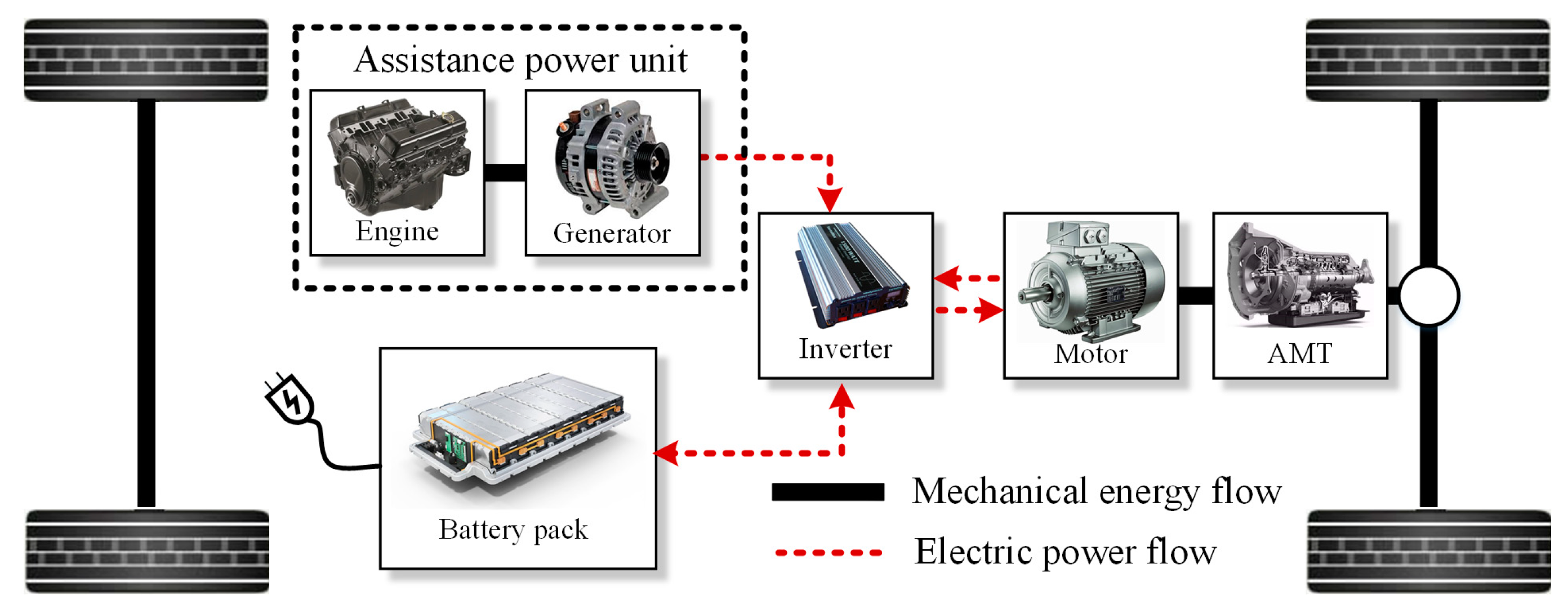
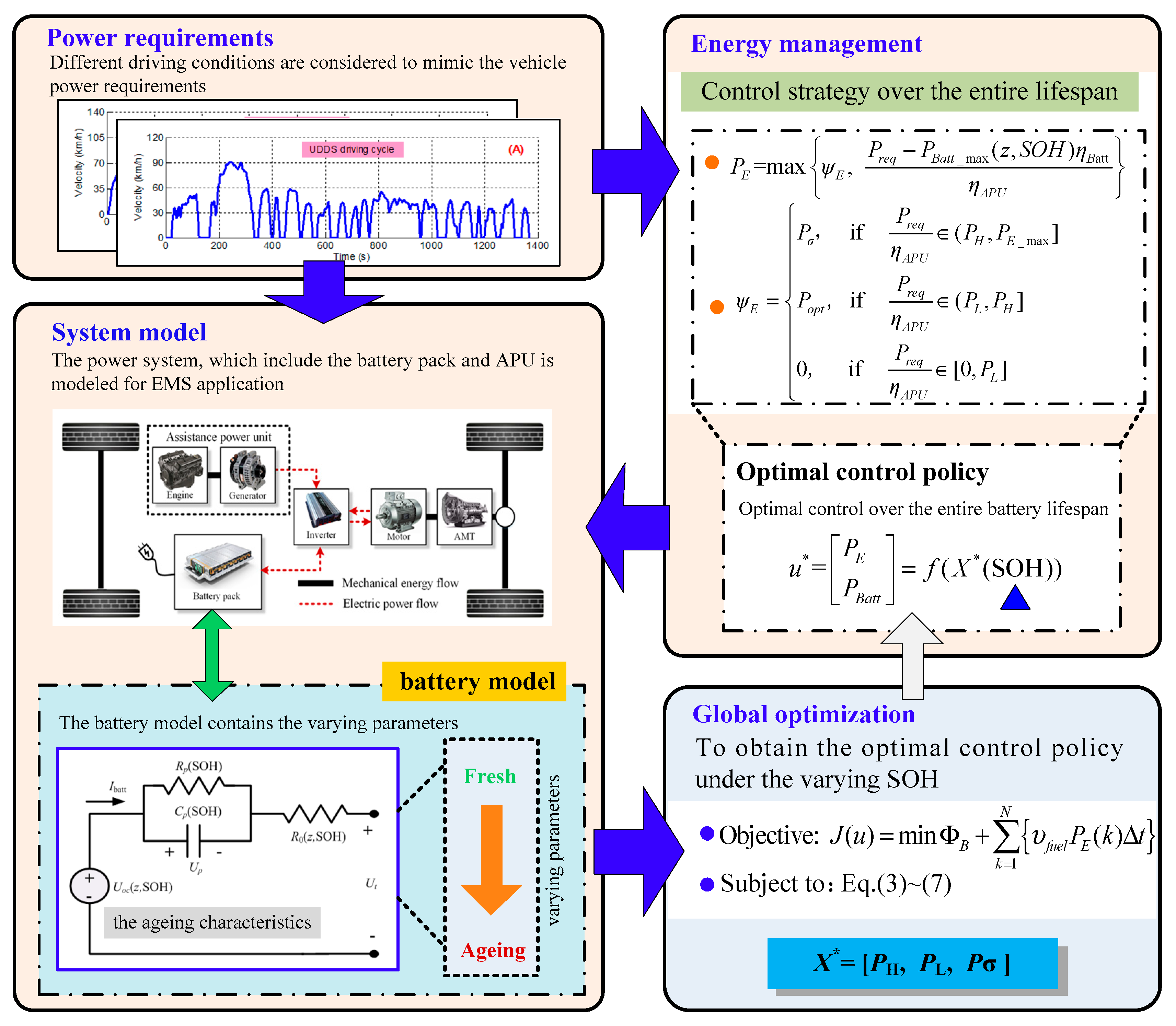



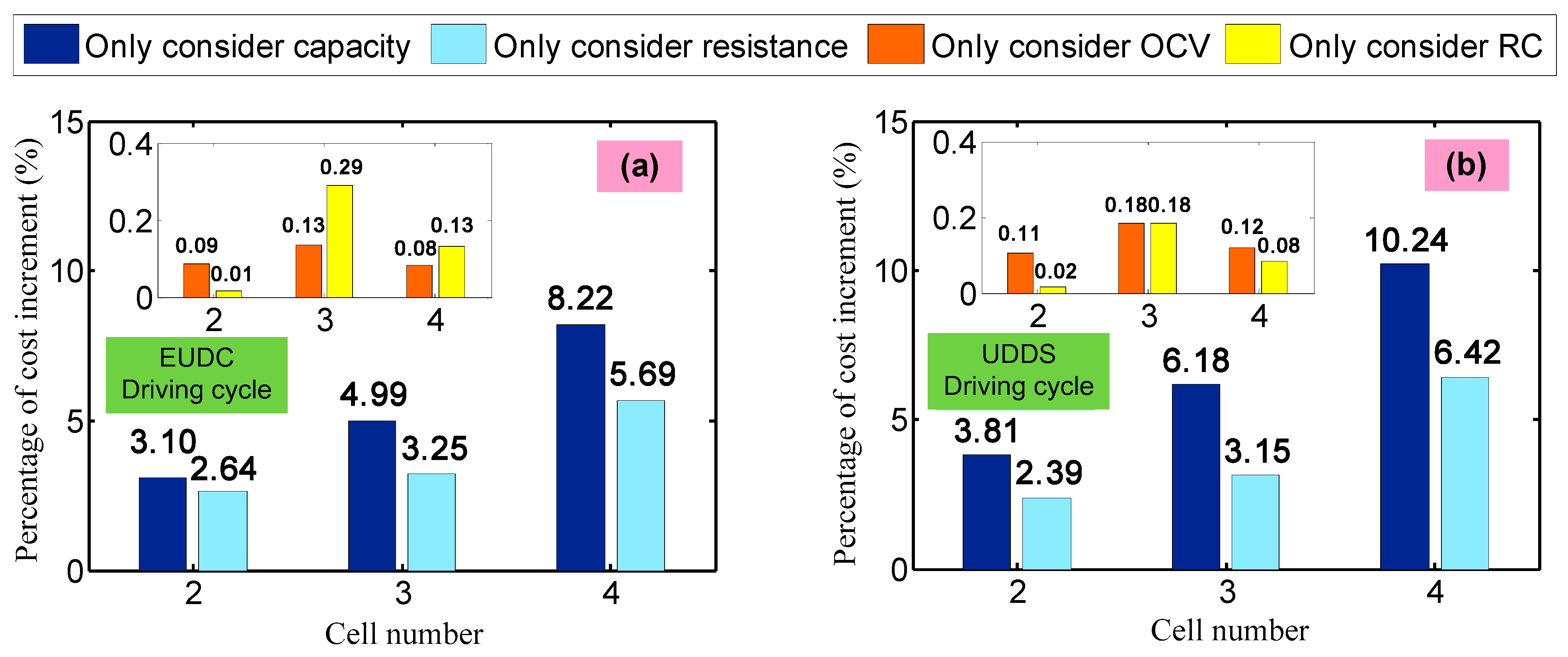
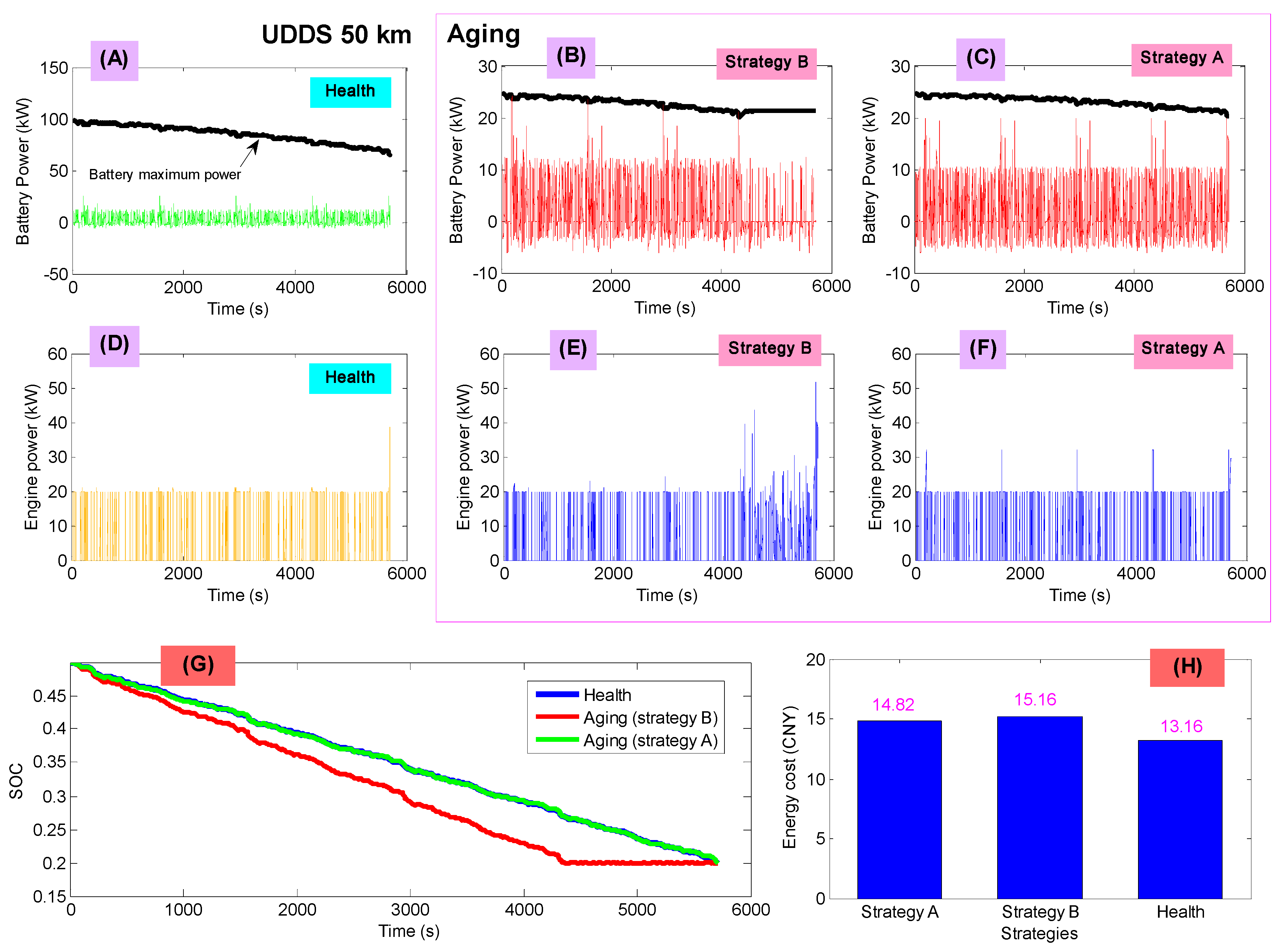
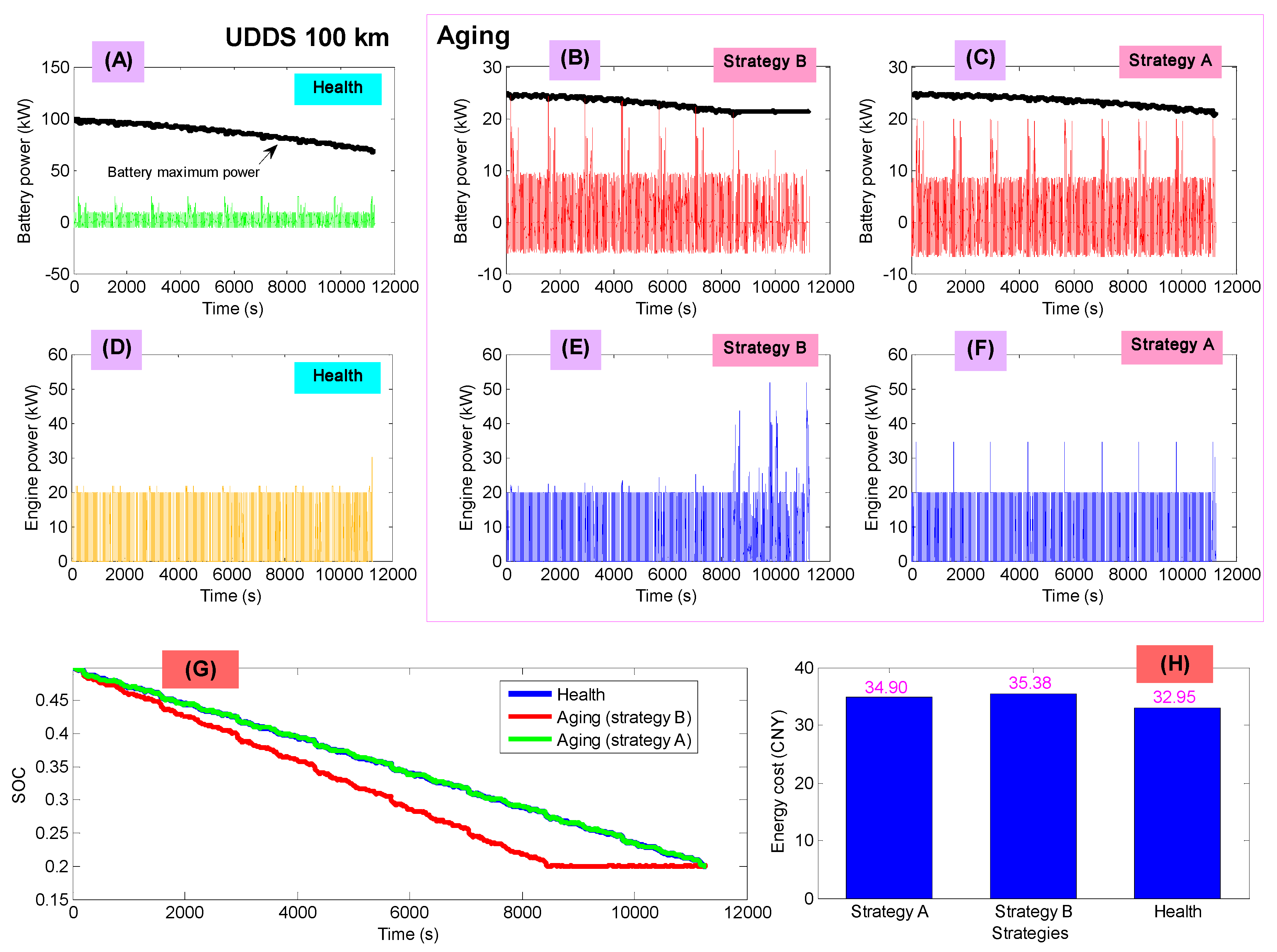
| Battery Number | 1 | 2 | 3 | 4 |
|---|---|---|---|---|
| Capacity | 1.299 | 1.217 | 1.158 | 1.071 |
| SOH | 96.21% | 90.13% | 85.76% | 79.34% |
| Parameters | Value |
|---|---|
| Nominal capacity/Ah | 1.35 |
| Nominal voltage/V | 3.2 |
| Temperature range/°C | −20–60 |
| Charge cut-off voltage/V | 3.65 |
| Discharge cut-off voltage/V | 2.5 |
| Internal resistance/mΩ | 33 |
| SOH | τ | Rp(mΩ) | b1 | b2 | b3 | b4 | b5 | a1 | a2 | a3 | a4 | a5 | a6 |
|---|---|---|---|---|---|---|---|---|---|---|---|---|---|
| 96.21% | 52.1 | 69.9 | 0.1 | −0.4 | 0.55 | −0.31 | 0.12 | −3.1 | 50.0 | 3.14 | 0.61 | −0.84 | 0.44 |
| 93.28% | 49.7 | 57.0 | 1.8 | −3.9 | 2.88 | −0.89 | 0.22 | 26.8 | 73.0 | 3.12 | 0.69 | −0.99 | 0.52 |
| 91.60% | 42.7 | 56.3 | 1.4 | −2.8 | 1.89 | −0.56 | 0.20 | −475 | 475 | 3.17 | 0.54 | −0.85 | 0.51 |
| 90.13% | 51.2 | 70.2 | 0.3 | −0.8 | 0.69 | −0.29 | 0.18 | 301.9 | 310.1 | 3.12 | 0.74 | −1.09 | 0.59 |
| 89.40% | 52.1 | 68.2 | 0.6 | −1.5 | 1.29 | −0.51 | 0.14 | −498.0 | 116.7 | 3.12 | 0.70 | −1.0 | 0.53 |
| 88.60% | 51.7 | 78.4 | 0.3 | −0.7 | 0.53 | −0.22 | 0.22 | 479.9 | 138.0 | 3.13 | 0.67 | −0.99 | 0.55 |
| 88.05% | 48.5 | 75.5 | 0.2 | −0.6 | 0.55 | −0.27 | 0.16 | −475 | 139.9 | 3.13 | 0.65 | −0.94 | 0.51 |
| 87.38% | 50.1 | 71.5 | 0.2 | −0.6 | 0.62 | −0.31 | 0.25 | 483.5 | 145.9 | 3.13 | 0.64 | −0.92 | 0.49 |
| 85.73% | 49.8 | 72.2 | 0.2 | −0.3 | 0.14 | −0.07 | 0.12 | 10.5 | 72.3 | 3.12 | 0.69 | −1.01 | 0.55 |
| 84.56% | 49.1 | 75.3 | 0.4 | −1.0 | 0.90 | −0.37 | 0.17 | 4.7 | 54.6 | 3.1 | 0.79 | −1.18 | 0.63 |
| 82.61% | 46.7 | 72.7 | 0.6 | −1.4 | 1.24 | −0.49 | 0.19 | 0.8 | 41.5 | 3.1 | 0.78 | −1.14 | 0.61 |
| 81.26% | 53.6 | 69.5 | 0.4 | −0.9 | 0.73 | −0.27 | 0.24 | 1.2 | 51.0 | 3.12 | 0.69 | −1.02 | 0.55 |
| 79.34% | 55.7 | 66.4 | −0.3 | 0.4 | 0.07 | −0.18 | 0.29 | 270.3 | 356.8 | 3.12 | 0.71 | −1.03 | 0.54 |
| SoH | Driving Distance: 50 km | Driving Distance: 100 km | ||||
|---|---|---|---|---|---|---|
| Strategy A | Strategy B | Reduction | Strategy A | Strategy B | Reduction | |
| 96.21% | 13.16 | 13.16 | -- | 32.95 | 32.95 | -- |
| 90.13% | 13.75 | 13.90 | 1.08% | 33.63 | 33.83 | 0.59% |
| 85.76% | 14.13 | 14.34 | 1.46% | 34.05 | 34.38 | 0.96% |
| 79.34% | 14.82 | 15.16 | 2.24% | 34.90 | 35.38 | 1.36% |
| SoH | Driving Distance: 50 km | Driving Distance: 100 km | ||||
|---|---|---|---|---|---|---|
| Strategy A | Strategy B | Reduction | Strategy A | Strategy B | Reduction | |
| 96.21% | 13.30 | 13.30 | -- | 33.26 | 33.26 | -- |
| 90.13% | 13.86 | 14.02 | 1.14% | 33.84 | 34.08 | 0.70% |
| 85.76% | 14.23 | 14.41 | 1.25% | 34.22 | 34.52 | 0.89% |
| 79.34% | 14.86 | 15.20 | 2.24% | 34.91 | 35.40 | 1.38% |
© 2020 by the authors. Licensee MDPI, Basel, Switzerland. This article is an open access article distributed under the terms and conditions of the Creative Commons Attribution (CC BY) license (http://creativecommons.org/licenses/by/4.0/).
Share and Cite
Chen, Z.; Lu, J.; Liu, B.; Zhou, N.; Li, S. Optimal Energy Management of Plug-In Hybrid Electric Vehicles Concerning the Entire Lifespan of Lithium-Ion Batteries. Energies 2020, 13, 2543. https://doi.org/10.3390/en13102543
Chen Z, Lu J, Liu B, Zhou N, Li S. Optimal Energy Management of Plug-In Hybrid Electric Vehicles Concerning the Entire Lifespan of Lithium-Ion Batteries. Energies. 2020; 13(10):2543. https://doi.org/10.3390/en13102543
Chicago/Turabian StyleChen, Zeyu, Jiahuan Lu, Bo Liu, Nan Zhou, and Shijie Li. 2020. "Optimal Energy Management of Plug-In Hybrid Electric Vehicles Concerning the Entire Lifespan of Lithium-Ion Batteries" Energies 13, no. 10: 2543. https://doi.org/10.3390/en13102543
APA StyleChen, Z., Lu, J., Liu, B., Zhou, N., & Li, S. (2020). Optimal Energy Management of Plug-In Hybrid Electric Vehicles Concerning the Entire Lifespan of Lithium-Ion Batteries. Energies, 13(10), 2543. https://doi.org/10.3390/en13102543




